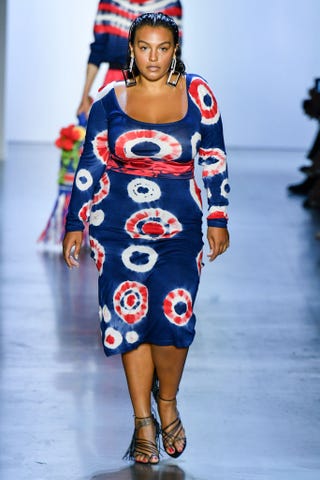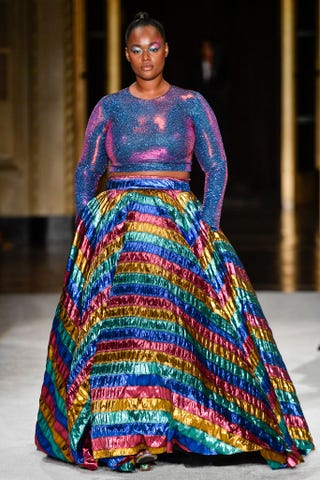When Ashley Graham posted a photo of her body on Instagram last summer, it shouldn’t have been particularly radical. Seeing Graham, a supermodel, in this capacity is what her followers may expect. But this photo was different. An intimate close-up of Graham, who had recently shared her pregnancy, it showed stretch marks, dimples of cellulite, and, maybe most meaningfully, rolls of flesh at her bra line and stomach. The photo amassed more than 1.4 million likes and over 23,000 comments, many of which included heart emoji, thank-yous, and the word Beautiful over and over. The reverence and appreciation from her followers was as overwhelming as the obvious craving for more pictures like it.
Body diversity isn’t Graham’s mission alone. In the last few years, the body positivity movement has infiltrated the world’s social media feeds, news reports, and pop culture consciousness, and with it a fascinating trend has bubbled up: a focus on a body part that many (even I, as a plus-size—or, my preferred descriptor, “fat”—body image advocate) struggle to embrace—the soft and squishy stomach.
Curvier women with this feature are often called “Rubenesque,” after the voluptuous female nudes famously captured in great fleshy detail by painter Peter Paul Rubens five centuries ago—women whose body type was an ideal of the time. Rubens’s subjects, usually themes from Greek mythology, often included women lounging or twisting about, their bodies irresistibly soft-looking. The Flemish artist is quoted as saying, “My passion comes from the heavens, not from earthly musings.” Whether that was specifically about painting women or not, it certainly speaks to “heavenly bodies.” They are otherworldly. And suddenly Rubenesque is starting to feel more and more modern (and desirable) today.
On the modern-day canvas of Instagram, curvy models like Paloma Elsesser, Tara Lynn, Ali Tate Cutler, Tess Holliday, and Charli Howard have amassed devoted social followings, often garnering more likes and engagement when they post clear images of their “rolls.” Some influencers, like Megan Jayne Crabbe, who has more than a million followers, have built entire communities around normalizing their shape.
On the runway, rolls were anything but hidden at Rihanna’s Savage x Fenty show, where models like Margie Plus, Raisa Flowers, and Alva Claire walked in the singer’s cult-loved lingerie (lauded for its size range of XS–3X and 32A–46DDD). What once was almost always hidden has now moved proudly front and center. Witnessing this celebration of a body type we used to singularly abhor brings me an indescribable amount of joy; it’s apparent that a cultural shift is happening.
But the shift hasn’t been simple and linear. It’s a complex evolution that has happened over years and, now, seemingly minute by minute on our social feeds, with activists, hashtags, and bold, unapologetic photos in mass volume. Despite trolls in the comments, it’s still this visual exposure—and new celebration, not just voyeurism—that fosters acceptance. Not unlike the way our eyes need to adjust to the new silhouettes that show up on the runway each season, repeated exposure to images of larger bodies can help break our fixation on the singular skinny ideal. A UK study found that showing participants a “visual diet” with more images of larger figures made them view these bodies more favorably.
Of course, because our conditioning runs incredibly deep, in that same study there was a persistent weight bias among the participants. Yet the results showed that neuroplasticity seems to work, and the more visual proof we see of the size diversity that exists in our world, the more we will increase our ability to appreciate all bodies, including our very own.
Historically, the shape of a woman’s body has seen significant shifts in what’s been considered ideal. Shape underwear has included bustles, corsetry, and bullet bras; desirable silhouettes have varied from hourglass 1950s pinups to Twiggy to Kim Kardashian.
Over time, a mandate of thinness fused with a long cultural tradition of policing women’s bodies, and a specific preoccupation with women’s midriffs. Millions of women know that preoccupation as the emotional ordeal of trying on a two-piece swimsuit. It’s only recently that plus-size in influencers like Gabi Gregg have shed light on the “fatkini”—a bikini made for larger bodies. So while you can find a few crop tops in the plus section of mass retailers like ASOS and from designer advocates like Christian Siriano and Prabal Gurung, plus-sizes are still only about 7 percent of the retail market, leaving the average woman, a size 16, with far fewer shopping choices.
Given this history, redefining what we consider beautiful or even acceptable isn’t as easy as marching a new hemline down a runway. It’s an uphill battle. Consistent imagery of plus-size models does help turn the tide, but some of the most popular plus models are still below average size and often have relatively flat stomachs.
For me, as a fat woman with a still-socially-taboo protruding stomach, these images leave me feeling like even more of a pariah: too large to be included, even within the world of body acceptance. The lack of images of stomachs that have rolls without bending over leaves a lot of women still out of the revolution. Many activists have to ask: “Where are the arm rolls? Where are the thigh rolls?” The answer seems quite obvious: Arm and thigh rolls often require a level of fatness that is still a mark of unhealthiness, regardless of the fact that size and health aren’t equivalents. The body positivity movement still has a weight limit, for now.
In the beginnings of the current change driven on social media, the movement had uncomfortable starts, as most movements do. Gina Susanna, the body acceptance advocate behind the popular body positive Instagram account @nourishandeat, shared her struggle with a severe eating disorder for years, including her recovery. “I started posting what felt radically liberating: photos of myself, no longer hiding my soft, squishy parts but highlighting them, embracing them,” Susanna says. “And I created a hashtag that resonated with this personally momentous step: #embracethesquish. Before I knew it, #embracethesquish took off.”
But alongside hundreds of messages of gratitude came a flood of comments calling out Susanna for highlighting her “thin privilege,” leaving her both confused and hurt.
“Body positivity is for everyone, I thought,” she shared with me years later, after she had time to reassess her mission. “Just because my body doesn’t represent everyone, that doesn’t make my message harmful…right? Wrong. My healing exists within a larger framework of privilege and oppression. Nothing exists in a vacuum.”
For many women, however, “embracing the squish” is a big first step—a crack in a strong foundation that has long hidden fat away, or attached a layer of shame to a body that didn’t appear like the “norm” when naked. There are now close to 44,000 #embracethesquish hashtags on Instagram.
The word squish itself holds such potential for positivity that model and author Charli Howard even launched a beauty line named Squish earlier this year, supported by a social media community rooted in Howard’s outspoken body positivity agenda. Every step away from thinness glorification, be it a beauty product, a follow, a selfie, or a conversation, is a win for the person taking this step.
When we see images of bodies that repulse or disgust us, these reactions are not related to health or actual beauty in any way. Not really. They are compulsive reactions tied to long-held stories about our own bodies. Indeed, our eyes do adjust to new body shapes similarly to new silhouettes—but it takes time. And a lot more exposure than a few runway shows. That’s because body size is still a built-in part of our identity and our culture that runs deeper than fashion. We can’t see different body types just a little bit. Our visual diet must be heartily generous.
But what I love about body liberation is that our freedom from body shame is inherently interconnected. We’re all in this together. And while we can applaud the normalization of the Rubenesque rolls in specific corners of the media, the next step is expanding the physical diversity we celebrate even further. The most beautiful thing of all? When all sizes are normalized, when there is no one perfect norm, everyone is set free. You and me included.
A version of this article originally appeared in the November 2019 issue of ELLE.



